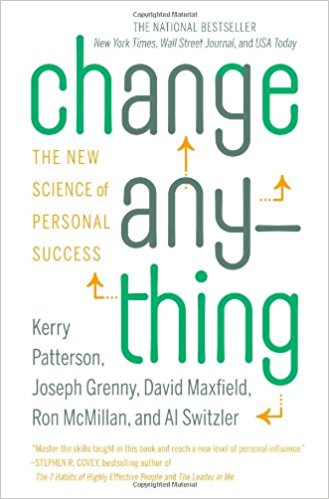“Great things in business are never done by one person.
They’re done by a team of People.”
-Steve Jobs
We are continuing a series focused on getting leverage on yourself to make personal changes. This week, we will focus on the third and fourth of the sources of influence that Patterson, Grenny, Maxfield, McMillan, and Switzler’s (2011) identifed in Change Anything: The New Science of Personal Success.
The Six Sources of Influence
The six sources of influence are listed below. I will describe each of them in some detail over the next few weeks, but for now, here is a list:
Source 1 – Personal motivation (What do you need to do to “love what you hate?”)
Source 2 – Personal ability (How will you “do what you can’t?”)
Sources 3 & 4– Social motivation & social ability (What must you do to “turn accomplices into friends?”)
Source 5 – Structural motivation (How will you “invert the economy?”)
Source 6 – Structural ability (What will you do to “control your space?”)
This week, we will talk about Source 3 and Source 4.
Sources 3 & 4– Social Motivation & Social Ability
The authors talk about these sources of influence as turning “accomplices” into “friends.” Friends are those who support you as you pursue your objective. Accomplices, on the other hand, are the people who conspire with you in making poor choices. They are the loved ones who urge you to have a small piece of cake when they know that you are watching your weight. They urge you to go shopping when they know you are trying to save money. As the authors explained, “Bad habits are almost always a social disease—if those around us model and encourage them, we’ll almost always fall prey. Turn ‘accomplices’ into ‘friends’ and you can be two-thirds more likely to succeed.”[i]
The good news is that you can often convert accomplices into friends. A loved one who stops eating cake in front of you and regularly asks about your weight loss becomes a powerful force in your change effort. Converting accomplices into friends is like removing an adversaries from the battlefield by converting them into allies who fight on your side. Now, these friends enable us to accomplish our goals.
You convert accomplices to friends by having a conversation with them. Tell them what you need from them. Ask them to help you as you pursue your goal.
You can gain extra leverage on yourself by making your goal public. Then everyone knows that your goal what your goal is. When you put your reputation on the line, you feel more compelled to complete your goal. I did this as I pursued my goal. I told my class that I would learn 7th grade Latin while they were conducting their change projects and I gained additional leverage with the following announcement.
I made myself publicly accountable to the entire class. I did this to give myself social motivation. I do not want to tell my students to do something and look like a hypocrite if I cannot do it myself. In the process, I have converted a number of students into friends. You can also ask me about my progress over the next three months (new friends). That is additional accountability.
That is how you get by with a little help from your friends.
What About You?
What is your goal this year? How can you put these two social sources of influence to work for you?
References
[i] Patterson, K., (2011). Change anything: The new science of personal success. New York: Business Plus. (p. 17).
______________

Dr. Darin Gerdes is an Associate Professor of management in the School of Business at Charleston Southern University. All ideas expressed on www.daringerdes.com are his own.
This post was originally created for Great Business Networking (GBN), a networking organization for business professionals where Dr. Gerdes is the Director of Education.

